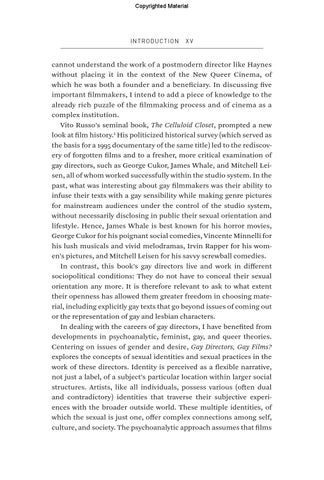Copyrighted Material
In t r oduc t ion x v
cannot understand the work of a postmodern director like Haynes without placing it in the context of the New Queer Cinema, of which he was both a founder and a beneficiary. In discussing five important filmmakers, I intend to add a piece of knowledge to the already rich puzzle of the filmmaking process and of cinema as a complex institution. Vito Russo’s seminal book, The Celluloid Closet, prompted a new look at film history.1 His politicized historical survey (which served as the basis for a 1995 documentary of the same title) led to the rediscovery of forgotten films and to a fresher, more critical examination of gay directors, such as George Cukor, James Whale, and Mitchell Leisen, all of whom worked successfully within the studio system. In the past, what was interesting about gay filmmakers was their ability to infuse their texts with a gay sensibility while making genre pictures for mainstream audiences under the control of the studio system, without necessarily disclosing in public their sexual orientation and lifestyle. Hence, James Whale is best known for his horror movies, George Cukor for his poignant social comedies, Vincente Minnelli for his lush musicals and vivid melodramas, Irvin Rapper for his women’s pictures, and Mitchell Leisen for his savvy screwball comedies. In contrast, this book’s gay directors live and work in different sociopolitical conditions: They do not have to conceal their sexual orientation any more. It is therefore relevant to ask to what extent their openness has allowed them greater freedom in choosing material, including explicitly gay texts that go beyond issues of coming out or the representation of gay and lesbian characters. In dealing with the careers of gay directors, I have benefited from developments in psychoanalytic, feminist, gay, and queer theories. Centering on issues of gender and desire, Gay Directors, Gay Films? explores the concepts of sexual identities and sexual practices in the work of these directors. Identity is perceived as a flexible narrative, not just a label, of a subject’s particular location within larger social structures. Artists, like all individuals, possess various (often dual and contradictory) identities that traverse their subjective experiences with the broader outside world. These multiple identities, of which the sexual is just one, offer complex connections among self, culture, and society. The psychoanalytic approach assumes that films
